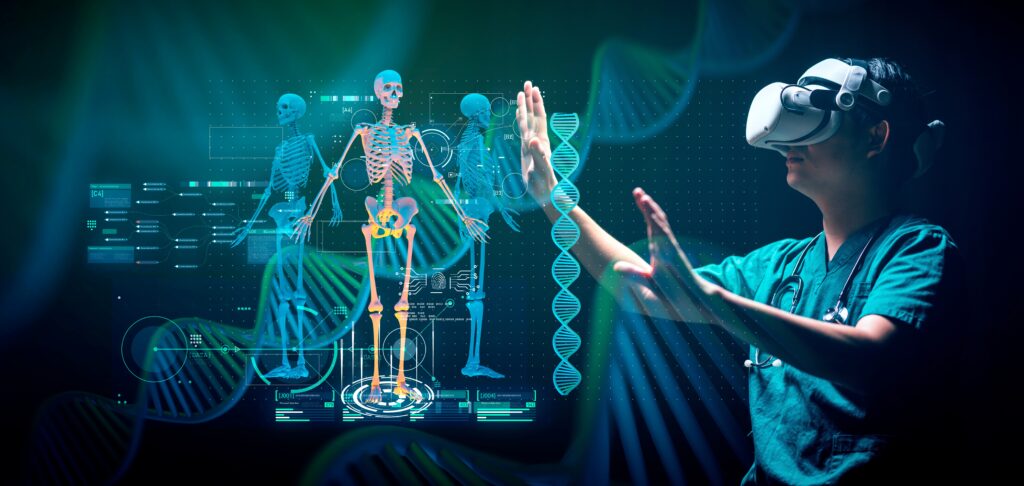How health sciences innovation is changing medical education
The next generation of healthcare professionals will benefit from a transformation in training, enabling them to nurture innovations in care delivery.

Have you ever contemplated the trajectory of healthcare? Will the health facilities of the future mirror those we are familiar with, or are we on the cusp of a radical transformation?
Now, we will investigate the exciting arena of health sciences innovation and its profound influence on medical education, laying the foundation for a new generation of healthcare professionals – a league distinct from any we've encountered before.
The inception of the innovation era
In the current era, where technological evolution occurs at a staggering pace, transformations previously consigned to the realm of science fiction are now becoming reality. Autonomous vehicles, AI-driven appliances and personal digital assistants have become commonplace. This rapid technological growth has implications far beyond consumer industries, significantly altering the landscape of healthcare and medical education.
Consider a medical student diagnosing a virtual patient using augmented reality (AR), or a surgical trainee performing intricate procedures on 3D-printed organs before even setting foot in an operating theater. These concepts, previously viewed as far-fetched, are rapidly becoming standard in medical training institutions worldwide, demonstrating the profound ways that innovative science is changing medical education.
The archetypical classroom, characterized by chalkboards and textbooks, is gradually evolving to accommodate technology-driven pedagogical approaches. Consider the following:
- • Simulation and virtual reality (VR) is enabling medical training that is transcending traditional constraints. With VR, students can immerse themselves in virtual environments replicating real-life clinical scenarios. This risk-free platform permits learners to err, learn and improve without any real-world ramifications.
- • Artificial Intelligence (AI) is becoming an integral instrument in medical education. It's enabling individualized learning pathways, facilitating interactive and adaptive learning experiences, and even assisting in predictive analysis of patient data.
- • 3D printing technology has introduced an entirely new facet to the teaching of anatomy and surgery. By creating accurate, tangible models of anatomical structures, it enables a hands-on approach to learning, enhancing understanding of complex biological systems.
The rising importance of big data
In the information age, the significance of big data in medical education is becoming increasingly apparent. The analysis of vast datasets enables the identification of patterns and insights that can inform both medical practice and education.
From predicting disease trends and patient behaviors to developing new treatment protocols, big data is instrumental in shaping the next generation of healthcare professionals.
However, as technology propels medical education into the future, it also presents a new array of ethical challenges. How do we maintain patient privacy in the era of big data? How can we ensure AI does not perpetuate existing biases? As we shape the healthcare professionals of tomorrow, it's vital to equip them with both the technological acumen and the ethical compass to navigate these complex issues.
The influence of telemedicine
Telemedicine – the provision of healthcare remotely via technology – has been gaining traction, and this trend is reflected in medical education as well. Students now can observe and even participate in patient consultations, follow-up visits and case discussions from anywhere in the world. This exposure not only broadens their horizons but also prepares them for a future in which telemedicine might become the norm.
Innovation in health sciences has fostered greater interdisciplinary collaboration between different fields of study. Medical students now have the chance to collaborate with engineers, data scientists and AI specialists, creating a learning environment that is both enriching and diverse. This collaborative approach fosters innovation, endows students with a broader skill set and prepares them for a future in which healthcare will increasingly rely on the intersection of various disciplines.
Looking forward, the potential of health sciences innovation to transform medical education is immense. As technologies continue to evolve, we can anticipate even more significant changes.
Whether it's the use of advanced AI algorithms for personalized learning or the application of blockchain technology for secure and transparent patient records, the future promises to be riveting.
However, it's crucial to note that with the rapid pace of innovation comes the necessity for a robust regulatory framework. As we navigate this journey into unexplored territories, we must ensure that the path we forge is not only innovative but also ethical and responsible.
In conclusion
The landscape of medical education is undergoing a radical transformation, driven by innovation in health sciences. The traditional model of medical education, characterized by textbook learning and clinical rotations, is yielding to a new paradigm. This emerging model embraces pioneering technologies such as VR, AI, 3D printing, big data, and telemedicine, nurturing a learning environment that is dynamic, interactive and aligned with the realities of modern healthcare.
The forthcoming generation of healthcare professionals are not merely being trained to be proficient doctors or nurses; they are being equipped to be innovators, problem solvers and ethical leaders in their field. The intersection of health sciences and technology is paving the way for a future where healthcare is more efficient, personalized, and accessible.
This encapsulates the profound ways in which health sciences innovation is changing medical education. It's a fascinating journey, and we're just at the beginning.
Kenneth R. Deans Jr. is president and CEO of Health Sciences South Carolina.